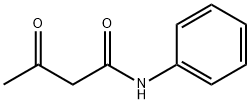아세토초산아닐리드
|
|
아세토초산아닐리드 속성
- 녹는점
- 83-88 °C (lit.)
- 끓는 점
- 129°C 24mm
- 밀도
- 1.26
- 증기 밀도
- 6.1 (vs air)
- 증기압
- 0-0.013Pa at 20-50℃
- 굴절률
- 1.5168 (estimate)
- 인화점
- 325 °F
- 저장 조건
- Refrigerator
- 용해도
- 클로로포름(약간 용해됨), 메탄올(약간 용해됨)
- 산도 계수 (pKa)
- 12.21±0.46(Predicted)
- 물리적 상태
- 결정성 분말
- 색상
- 하얀색
- 수용성
- 5g/L(20℃)
- Merck
- 14,58
- BRN
- 473419
- 안정성
- 안정적인. 타기 쉬운. 강한 산화제와 호환되지 않습니다.
- LogP
- 0.93 at 23℃
- CAS 데이터베이스
- 102-01-2(CAS DataBase Reference)
안전
- 위험 및 안전 성명
- 위험 및 사전주의 사항 (GHS)
| 위험품 표기 | Xn | ||
|---|---|---|---|
| 위험 카페고리 넘버 | 21/22 | ||
| 안전지침서 | 36 | ||
| RTECS 번호 | AK4200000 | ||
| 자연 발화 온도 | 843 °F | ||
| HS 번호 | 2921419000 | ||
| 유해 물질 데이터 | 102-01-2(Hazardous Substances Data) | ||
| 독성 | LD50 orl-rat: 5400 mg/kg LONZA# 08FEB79 | ||
| 기존화학 물질 | KE-27634 |
아세토초산아닐리드 C화학적 특성, 용도, 생산
화학적 성질
White to off-white powder용도
Acetoacetanilide is used as intermediate for the manufacture of organic pigments and dyestuffs.일반 설명
White crystalline solid.공기와 물의 반응
Water insoluble.반응 프로필
Organic amides react with azo and diazo compounds to generate toxic gases. Flammable gases are formed by the reaction of organic amides with strong reducing agents. Amides are very weak bases (weaker than water). Mixing amides with dehydrating agents such as P2O5 or SOCl2 generates the corresponding nitrile. The combustion of these compounds generates mixed oxides of nitrogen (NOx). Ketones are reactive with many acids and bases liberating heat and flammable gases (e.g., H2). The amount of heat may be sufficient to start a fire in the unreacted portion of the ketone. Ketones react with reducing agents such as hydrides, alkali metals, and nitrides to produce flammable gas (H2) and heat. Ketones are incompatible with isocyanates, aldehydes, cyanides, peroxides, and anhydrides. They react violently with aldehydes, HNO3, HNO3 + H2O2, and HClO4.건강위험
ACUTE/CHRONIC HAZARDS: Acetoacetanilide is a weak allergen. When heated to decomposition it emits toxic fumes.화재위험
Acetoacetanilide is combustible.Safety Profile
Poison by intraperitoneal route. Moderately toxic by ingestion. A weak allergen. See also ACETANILIDE. Combustible when exposed to heat or flame. See ANILINE and CYANIDE for disaster hazard. When heated to decomposition it emits toxic NOx, fumes. To fight fire, use alcohol foam, water mist, CO2, dry chemical.Purification Methods
Crystallise the anilide from H2O, aqueous EtOH or pet ether (b 60-80o). [Williams & Krynitsky Org Synth Coll Vol III 10 1955.]아세토초산아닐리드 준비 용품 및 원자재
원자재
준비 용품
2-히드록시-4-메틸퀴놀린
Solvent Yellow 19
Disperse Yellow S-3GL
DIRECT YELLOW 27
Acid Yellow 44
황색 116 산염료
Acid Yellow 128
2-CHLORO-3-OXO-N-PHENYLBUTANAMIDE
C.I. 색소 황색 13
염료 옐로우 1
Solvent Orange 45
Pigment Yellow 5
Seedavay(Uniroyal)
4-methylquinoline
C.I. 색소 황색 12
카복신
C.I. 산성 황색 059
황색 099 염료
Solvent Yellow 19
아세토초산아닐리드 관련 검색:
아세토아셋-2-카복시아니리드 아세토초산 m-자일리다이드 아세트초산 2,5-디메톡시아닐리드 아세토아세트-파라-톨루이디드 아세토초산아닐리드 아세토아세트-오르토-톨루이디드 아세트초산 o-클로로아닐리드 아세토초산 o-아니시다이드 아세트아닐리드 아세토아세트-P-페네티딘 C.I. 색소 황색 83 아세트초산-2,5-디메톡시-4-클로로아닐리드
N-(5-CHLORO-2-METHYL-PHENYL)-3-OXO-BUTYRAMIDE
4'-Chloro-2'-methylacetoacetanilide
2-BENZOYLACETANILIDE
4-BENZOYL-3-METHYL-1-PHENYL-5-PYRAZOLINONE
N-(3-Nitro-Phenyl)-3-Oxo-Butyramide
2',5'-DICHLOROACETOACETANILIDE








